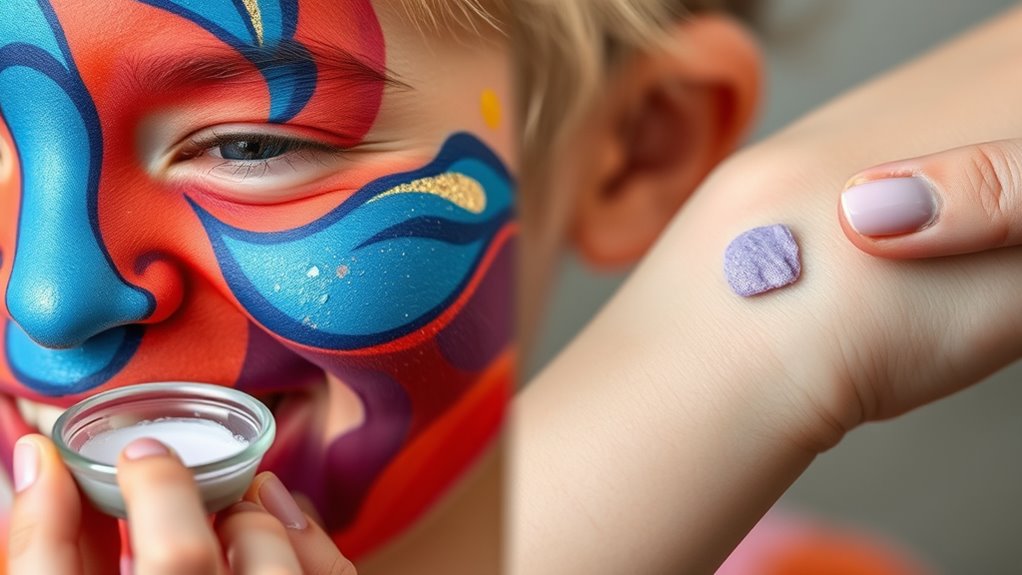To guarantee face paint safety, carefully check ingredient labels for natural or hypoallergenic options, avoiding vague terms like “fragrance” or “colorants.” Look for recognizable safe preservatives and avoid potential allergens like fragrances and certain dyes. Always perform a patch test on a discreet skin area 24-48 hours before use, monitoring for any reactions. If you want to learn how to choose the safest products and conduct effective tests, keep exploring these tips.
Key Takeaways
- Always check labels for detailed ingredient lists, avoiding vague terms like “fragrance” or “colorants.”
- Prefer face paints with natural ingredients or trusted certifications to reduce allergy risks.
- Conduct patch tests on discreet skin areas 24-48 hours before face painting to identify potential sensitivities.
- Monitor the patch test area for 24-48 hours, and wash immediately if any redness, swelling, or irritation occurs.
- Choose products with clear safety certifications (e.g., FDA, EU, cruelty-free) and avoid products with harmful chemicals like parabens or phthalates.
Understanding Common Face Paint Ingredients
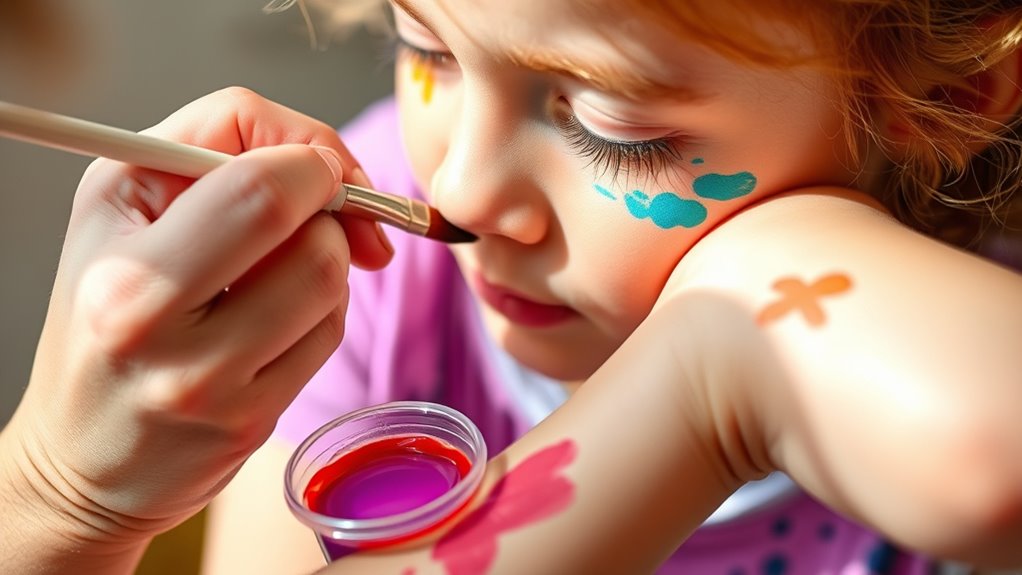
Knowing what’s in your face paint is essential for safe application, especially since sensitive skin and eyes are involved. Face paint colorants are the primary pigments that give your designs vibrant hues, but some may cause irritation if not carefully selected. Preservative agents are added to prevent microbial growth and extend shelf life, but certain preservatives can trigger skin reactions or allergies. It’s important to check labels for these ingredients and choose products labeled as hypoallergenic or suitable for sensitive skin. Avoid paints with harsh chemicals or unlisted additives. Being aware of the ingredients helps you make informed choices, reducing the risk of adverse reactions. Additionally, understanding the ingredients list can help identify potential allergens or irritants. Always opt for high-quality, tested face paints to ensure safety and enjoyment during your fun activities.
Recognizing Ingredients That May Cause Allergies

You should be aware of common allergy triggers like certain dyes and fragrances in face paints. Look for harmful chemical indicators, such as parabens or phthalates, on the labels. Knowing the difference between natural and synthetic ingredients helps you choose safer options for sensitive skin. Additionally, selecting products with certified natural ingredients can further reduce the risk of allergic reactions.
Common Allergy Triggers
Have you ever wondered which ingredients in face paints might trigger allergic reactions? Certain common allergens can be present in face paint application, especially if you’re using inexpensive or unbranded products. Ingredients like fragrances, preservatives, and dyes are frequent culprits. For example, parabens and formaldehyde-releasing preservatives can cause sensitivities. Bright dyes used in vibrant colors may also trigger reactions in sensitive skin. When planning your costume design techniques, pay close attention to labels and avoid products with known allergens. Conduct patch tests beforehand to prevent adverse reactions. Being aware of these common allergy triggers helps ensure a safe face paint experience, especially when working on children or individuals with sensitive skin. Recognizing these ingredients keeps your creative process both fun and safe. Additionally, understanding cookie consent management can help you navigate online product labels and safety information more effectively.
Harmful Chemical Indicators
Certain ingredients in face paints can act as warning signs of potential allergies, so it’s important to recognize harmful chemical indicators before application. Chemical preservatives, often used to extend shelf life, can sometimes trigger skin reactions or sensitivities. Look out for preservatives like parabens or formaldehyde-releasing agents, which are linked to allergic responses. Artificial fragrances are another red flag; they’re added for scent but can cause irritations or allergic reactions, especially for sensitive skin. If a product lists vague fragrance ingredients or contains known allergenic chemicals, it’s best to avoid it. Checking ingredient labels carefully helps you identify these harmful indicators and choose safer options. Being cautious with chemical preservatives and artificial fragrances reduces the risk of adverse reactions during face painting. For added assurance, verify the trustworthiness of skincare brands to ensure product safety and quality.
Natural vs. Synthetic
When choosing face paints, understanding the differences between natural and synthetic ingredients can help you avoid potential allergies. Natural ingredients, like plant extracts and minerals, often have fewer chemicals, which may improve face paint longevity and reduce irritation. However, some natural components can still cause allergic reactions, so patch testing is essential. Synthetic options, while sometimes more vibrant and durable, may contain preservatives or dyes that trigger sensitivities. To minimize risks, consider these points:
- Always check ingredient lists for known allergens
- Test new paints on a small skin area before full application
- Use proper application techniques to prevent irritation
- Opt for paints labeled hypoallergenic if you have sensitive skin
- Incorporating plant-based materials from natural face paints can sometimes decrease the likelihood of adverse reactions and promote a safer application experience.
Knowing these distinctions helps you select safer options and achieve better results.
Reading and Interpreting Product Labels
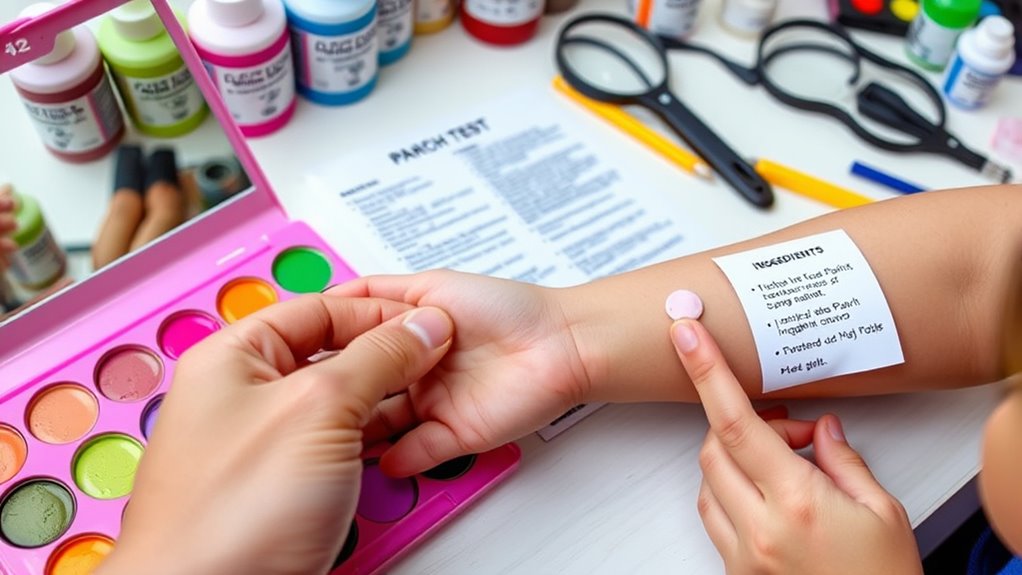
When you check face paint labels, make sure the ingredient list is clear and easy to understand. Look for any potential allergens and verify that the product has proper safety certifications. Knowing how to interpret these labels helps you choose safer options for everyone. Additionally, understanding label reading tips can help identify harmful ingredients and avoid products with questionable safety standards.
Ingredient List Clarity
Reading and interpreting product labels is essential to guaranteeing face paint safety. Clear labels help you assess face paint compliance and ingredient transparency, reducing the risk of allergic reactions or irritations. Look for labels that list all ingredients in plain language, not vague terms like “fragrance” or “colorants.” This transparency allows you to make informed choices, especially if you or the person being painted has sensitivities. Pay attention to expiration dates and manufacturer information, which also contribute to safe use. Remember, a well-labeled product makes it easier to identify potential allergens and confirm it meets safety standards. To ensure safe application, prioritize products with straightforward, detailed labels that promote ingredient transparency and compliance. Regularly checking for product safety standards can further ensure the face paint you choose is reliable and safe for use.
Checking for Allergens
Clear labels not only reveal ingredients but also help you spot potential allergens before applying face paint. Carefully reading product labels allows you to identify common allergens like dyes, preservatives, or fragrances that could trigger allergy symptoms. If you notice ingredients you’re sensitive to, avoid using that product. Knowing how to check for allergens also guides you in proper face paint removal, reducing the risk of irritation or prolonged exposure. If an allergic reaction occurs, symptoms such as redness, swelling, or itching may appear quickly, so promptly removing the face paint is essential. Always prioritize products with clear labels that list all ingredients, and keep an eye out for any known allergens to ensure safe fun without unexpected reactions. Additionally, understanding the role of patch tests can help prevent adverse reactions before full application.
Understanding Certification Labels
Have you ever looked at a face paint product’s label and wondered what all those symbols and certifications mean? Understanding certification labels helps guarantee you’re choosing safe products. Look for recognized symbols indicating cosmetic certifications, which confirm the product meets strict ingredient standards. These labels can tell you if the product is dermatologically tested, hypoallergenic, or free from harmful substances.
Some key points to keep in mind:
- Certifications like FDA or EU compliance show adherence to safety regulations.
- Ingredient standards are often highlighted through symbols or claims on the label.
- Look for labels indicating cruelty-free or vegan certifications if important to you.
- Always verify the authenticity of the certification to avoid misleading claims.
Reading labels carefully helps you pick safe, certified face paints for all uses.
Natural vs. Synthetic Face Paints
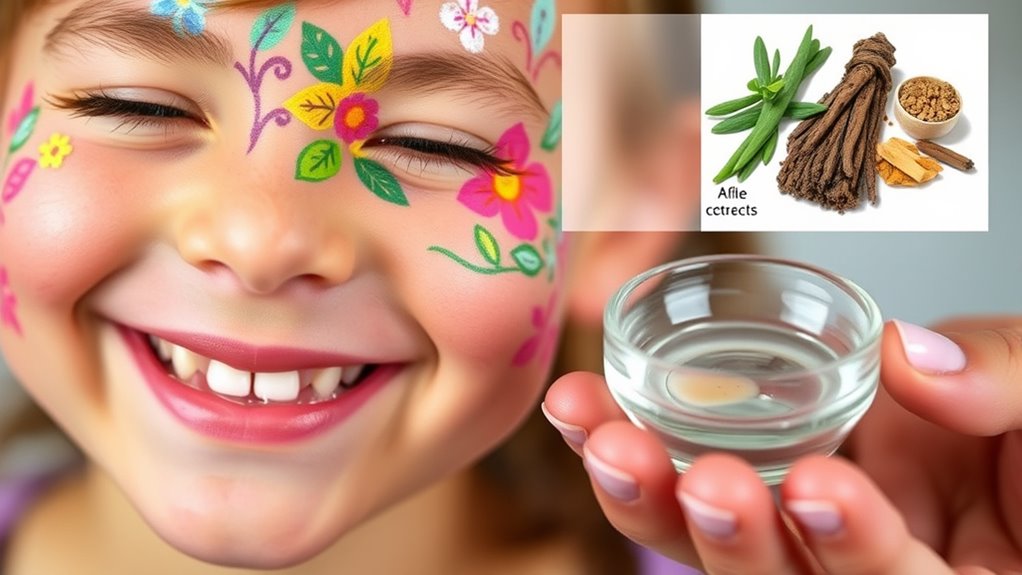
When choosing face paint, understanding the differences between natural and synthetic options is essential for safety and skin health. Natural face paints often contain plant-based ingredients, making them gentler but sometimes less durable. Synthetic paints usually offer better face paint longevity and brighter color vibrancy, ideal for detailed designs or long-lasting events. Here’s a quick comparison:
| Feature | Natural Face Paints | Synthetic Face Paints | Considerations |
|---|---|---|---|
| Ingredients | Plant extracts, mineral pigments | Synthetic dyes, preservatives | Natural may cause fewer allergies |
| Color Vibrancy | Softer, more muted tones | Bright, bold colors | Synthetic often more vibrant |
| Face Paint Longevity | Shorter-lasting | Longer-lasting | Synthetic lasts through sweat |
| Skin Safety | Generally safer, fewer chemicals | May contain irritants | Patch test recommended |
| Environmental Impact | Eco-friendly, biodegradable | Less eco-friendly | Natural preferred for eco-conscious |
Choosing depends on your priorities—safety, durability, or vibrancy. Additionally, selecting paints with safe ingredients can further minimize skin reactions.
Conducting an Effective Patch Test
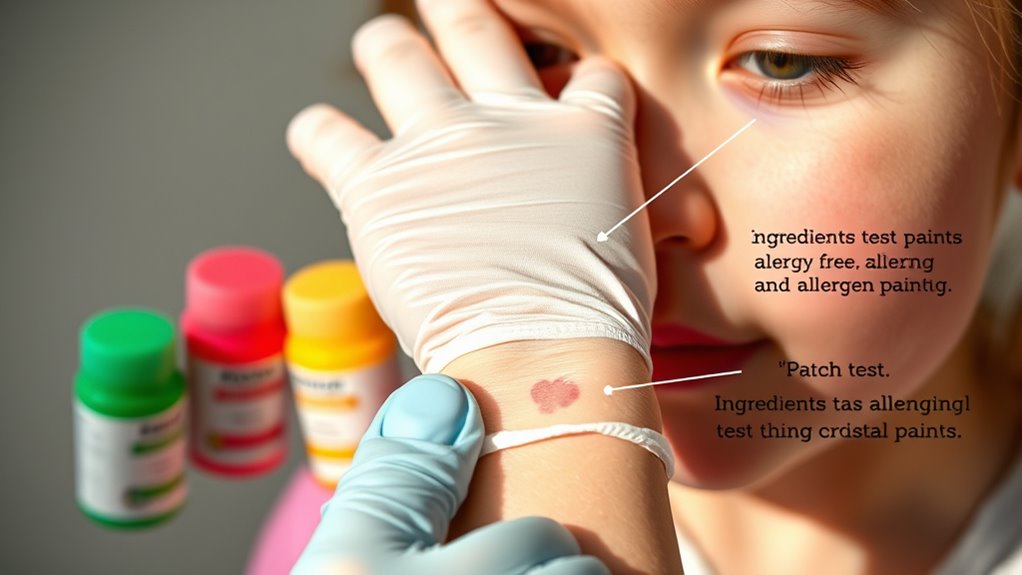
Performing a patch test is an essential step to guarantee that the face paint won’t cause an allergic reaction or irritation. To do this effectively, choose a small, discreet area of skin, like behind the ear or on the inner forearm. Use a minimal amount of the cosmetic formulation, focusing on the ingredients you sourced carefully. Remember, ingredient sourcing impacts safety, so verify the products are from reputable suppliers. Keep the test area clean and dry, and wait at least 24 hours before checking for any reactions.
- Always use freshly prepared or unopened products for testing
- Record the date and product details for future reference
- Avoid harsh scrubbing or irritating the test area
- If irritation occurs, discontinue use immediately
Timing and Location for Patch Testing
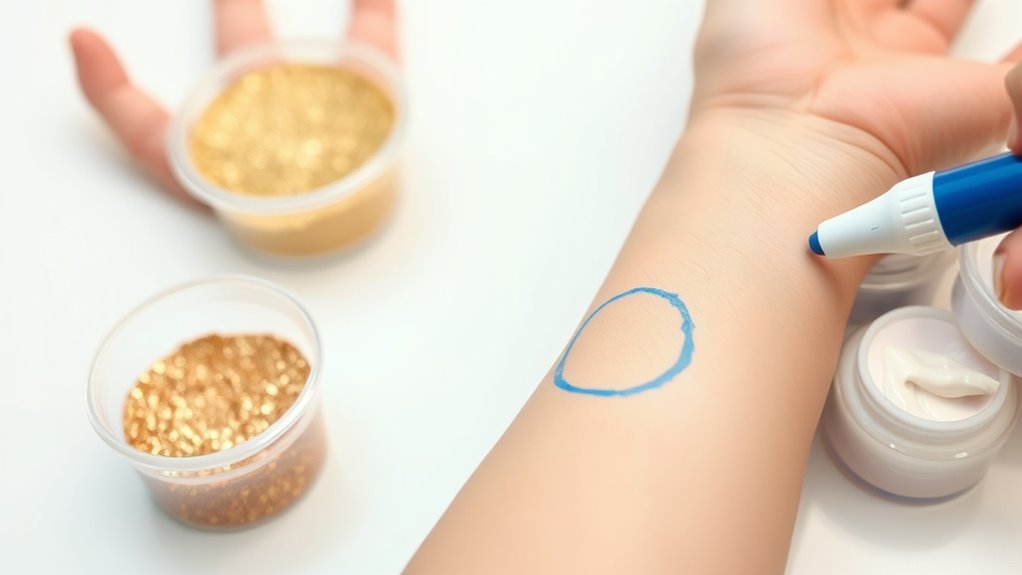
Choosing the right timing and location for your patch test is essential to accurately detect any allergic reactions. You should perform the test 24 to 48 hours before applying face paint, giving your skin enough time to respond. The best application timing is when your skin isn’t irritated or inflamed, ensuring accurate results. For patch test location, pick a discreet area such as behind your ear or on your inner forearm. These spots are less exposed and sensitive, making it easier to observe any reactions. Avoid areas with cuts, rashes, or irritation. Keep the patch test area clean and dry. Proper application timing and selecting an appropriate patch test location help you identify potential allergies early, reducing the risk of adverse reactions during face painting. Additionally, understanding efficient general ledger coding can streamline your preparation process, ensuring all safety protocols are accurately documented.
Monitoring for Reactions and What to Do Next
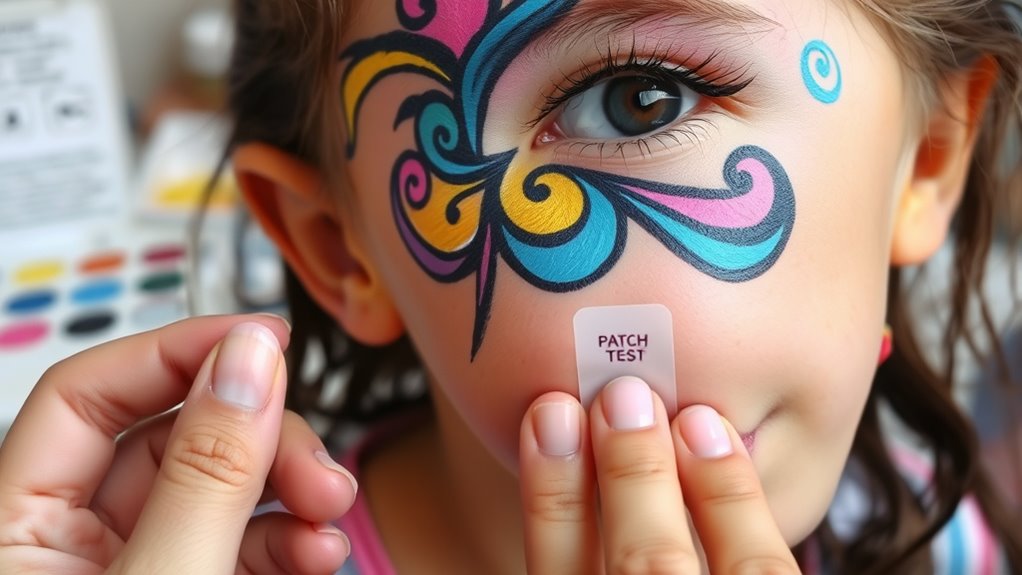
After completing your patch test, closely observe the area over the next 24 to 48 hours for any signs of an allergic reaction. Watch for redness, swelling, itching, or blistering, as these can indicate sensitivity. If you notice any of these symptoms, remove the face paint immediately and wash the area with soap and water. Prioritize child safety by acting quickly to prevent further irritation or discomfort. Remember, allergic reactions can worsen if ignored, so don’t hesitate to seek medical advice if needed. To stay vigilant:
- Keep an eye on the test area regularly
- Document any changes or symptoms
- Avoid applying face paint to the same spot again
- Consult a healthcare professional if a reaction occurs
- Proper patch testing is essential to prevent adverse reactions and ensure safe use of face paints.
Monitoring helps ensure safe fun and protects your child’s health.
Tips for Choosing Safe Face Paints
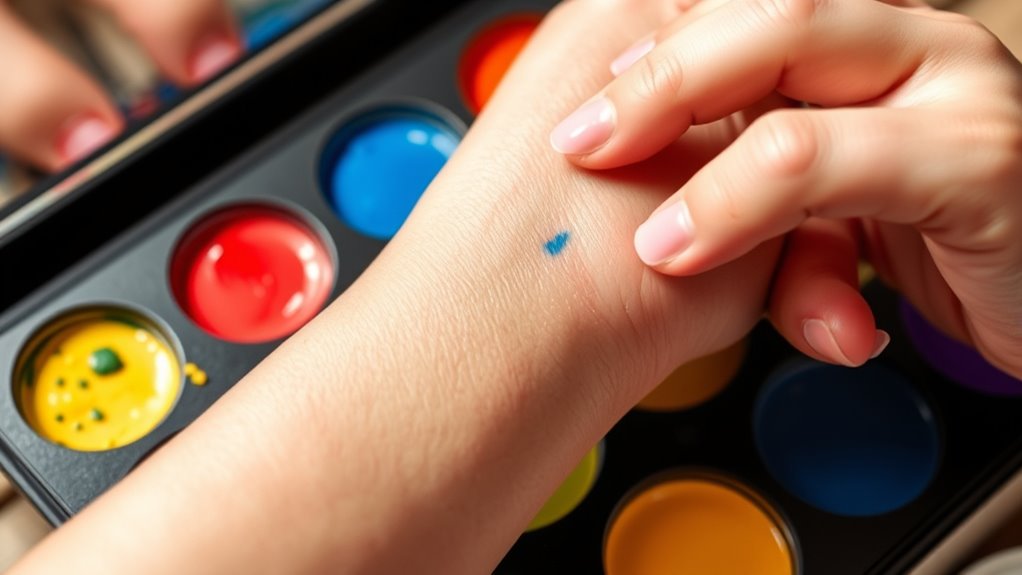
To guarantee your child’s safety, it’s essential to select face paints that are specifically designed for use on skin. Always choose products labeled as hypoallergenic and dermatologically tested. Check for ingredient transparency; reputable brands list all ingredients clearly, so you can avoid potential irritants or allergens. Avoid face paints with preservatives like parabens or fragrances, which can cause reactions. Opt for water-based paints over oil-based or glittery options, as they tend to be safer and easier to remove. Read reviews and look for certifications from safety organizations to ensure quality. Remember, the safest face paint is one from a trusted manufacturer that prioritizes face paint safety and ingredient transparency, giving you peace of mind during your child’s fun. Additionally, choosing face paints with approved ingredients can further reduce the risk of adverse reactions.
Alternatives for Sensitive Skin
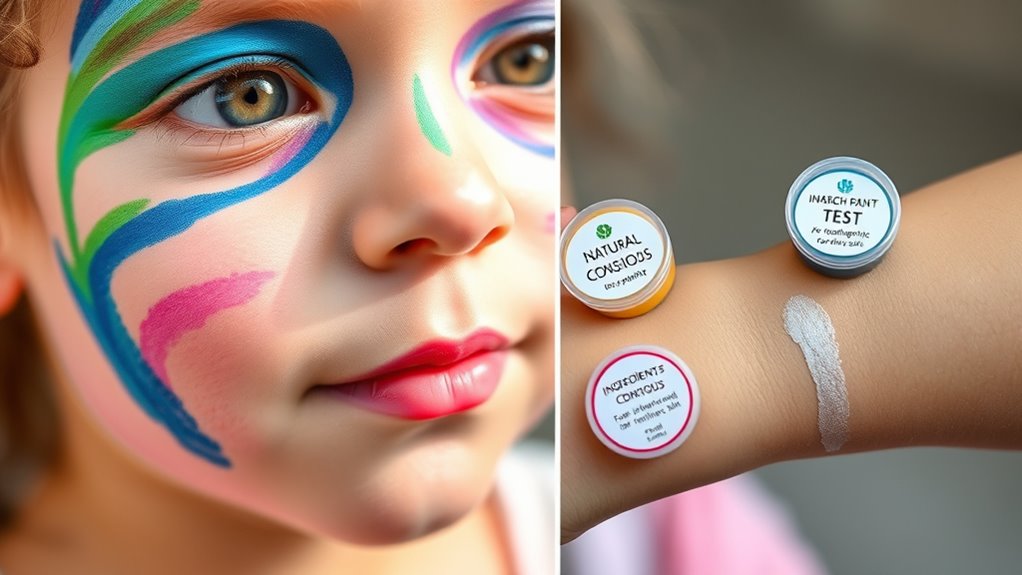
For children with sensitive skin, standard face paints might cause irritation or allergic reactions. To minimize this risk, consider using hypoallergenic options designed with skin-friendly formulations. These products often contain fewer irritants and are tested for safety. Look for paints labeled as suitable for sensitive skin, and always check ingredients before purchasing. You can also explore natural or organic face paints, which tend to be gentler on delicate skin. Additionally, applying a thin barrier like a moisturizer or primer can reduce direct contact with potentially irritating ingredients. Remember, patch testing new products is essential, even with hypoallergenic options. By choosing formulations specifically designed for sensitive skin, you can help ensure a fun, safe experience without discomfort.
Frequently Asked Questions
How Long Should I Wait After a Patch Test Before Applying Face Paint?
You should wait at least 24 hours after a patch test before applying face paint. This duration waiting allows you to observe any possible allergic reactions or skin irritations. The patch test timing is essential to guarantee safety, so don’t rush the process. If no redness, swelling, or irritation occurs within this period, it’s generally safe to proceed with face paint application. Always follow the specific instructions provided with the face paint product.
Can Natural Face Paints Still Cause Allergic Reactions?
Yes, natural face paints can still cause allergy concerns even with natural ingredients. You might think they’re completely safe, but natural ingredients can still trigger allergic reactions in sensitive skin. Always check the ingredient list, and do a patch test before applying. If you notice any redness or irritation, avoid using it. Being cautious helps prevent unwanted allergic reactions, even with natural face paints.
Are There Specific Ingredients to Avoid for Sensitive Skin?
Yes, for sensitive skin, you should avoid ingredients like fragrances, parabens, and certain dyes, even in hypoallergenic formulas. Look for face paints that follow FDA regulations, ensuring safety standards are met. Always check labels for ingredients and opt for products specifically designed for sensitive skin. Doing a patch test first can help prevent reactions, and choosing paints with minimal, natural ingredients reduces the risk of irritation.
How Often Should I Recheck for Reactions if Using Face Paint Repeatedly?
You should recheck for reactions every few uses, especially if you’re using the same reusable face paint. The frequency of allergy checks depends on how often you apply it and your skin’s sensitivity. For safety, do patch tests before each new application and monitor your skin closely. Regularly inspecting for signs of irritation helps prevent adverse reactions, ensuring your reusable face paint remains safe for repeated use.
What Are the Signs of a Delayed Allergic Reaction to Face Paint?
If you experience a delayed allergic reaction to face paint, watch for signs like rash development, swelling, or hives that appear hours or even days after application. You might notice redness, itching, or bumps on your skin. These symptoms indicate your body is reacting negatively. If you see these signs, remove the face paint immediately, wash the area, and consult a healthcare professional to prevent further reactions.
Conclusion
By knowing what’s in your face paint and performing patch tests, you can avoid surprises—no need to be a medieval knight defending against allergic dragons. Always read labels carefully, choose natural options if you have sensitive skin, and watch for reactions. Remember, safety should never be a quest for a legendary unicorn; it’s about protecting your skin today. Stay vigilant, and enjoy your fun without fear!
